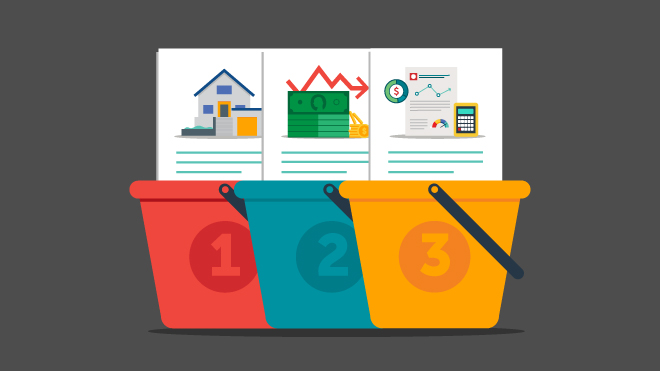Check the background of investment professionals associated with this site on FINRA'S BrokerCheck.
Financial health takes planning and persistence, and many Americans struggle to reach it. Wouldn't it be nice to alleviate your worries about money? It's very doable. But to get there, it's best to take a three-bucket approach to building wealth.
Bucket One: Living Expenses
You need to start by having a minimum of three to six months of living expenses saved (preferably six months). These savings should be set aside as liquid funds, so that you can access them without risk or penalties. These funds should be put into a financial institution where they can be protected from loss by federal deposit insurance.
This first bucket is critical, because it will “allow you to step over the potholes in the road to your financial goals.” Being able to cope with unexpected expenses like losing a source of income, paying for home or car repairs, or handling unexpected medical costs is a vital part of financial health.
Once you have three to six months of savings set aside, then what?
Save at least as much of your paycheck in a company retirement plan as the company matches. In many cases, that's an immediate return of 50-100% on the match alone. It's a lost opportunity if you don't.
Once you've filled bucket one and maximized any company retirement plans that are available to you, then you should start working on filling buckets two and three.
Bucket Two: Combat Inflation
If you are fortunate enough to have at least three to six months of savings put away and are matching your employer's retirement contribution, then it is time to look at other investing opportunities.
With interest rates still well below inflation, every dollar you have in a standard checking or savings account will lose its purchasing power over time. If inflation (the rising average cost of goods and services) is between 2-3% (as it is now), but you are earning less than that on your savings accounts, then every year you are losing 1-2% of the value on your savings.
Often, inflation will mean that the money you save in bucket one will lose value over time. In addition, as your family needs grow, your daily living expenses may increase. The solution is to create a second bucket, one in which you use your savings to invest in higher-risk funds that still produce income. These investments should provide a return on income, like stocks and mutual funds that pay a regular dividend.
You can use the income earned from this second bucket to top off your first bucket to ensure that you're still adequately covered for emergencies as your expenses and inflation increase.
Once you've filled bucket one and two, you'll start to feel some of that financial stress and worry melt away. You're well on your way to thriving financially! But there's more to do.
Bucket Three: Grow Your Portfolio
Investing is all about risk. There is no way around this fact. The more risk you take, the higher the returns. With bucket one and two in place, you've strengthened yourself financially, so bucket three is about investing in higher-growth vehicles and taking on more risk to grow your financial portfolio.
These investment vehicles are likely to change depending on your age and circumstance, so it's important to talk to your financial advisor about a customized approach. For example, if you're a GenX'er, your financial advisor may recommend:
-
Maximizing your 401(k)
-
Roth IRA's
-
Standard IRAs (if you don't have a company retirement plan)
-
Annuities
-
HSA accounts
-
Cash life insurance with riders to cover additional risks such as the need for long-term care
However, these investment vehicles may not be right for you, especially if you're a millennial or baby boomer. They also depend on your income. Ultimately, the questions to answer before choosing investment vehicles for bucket three include:
- What are your goals?
- How much time do you have before you'll need the money you're investing?
- What level of returns do you want?
- How much risk are you willing to take?
Understanding your own comfort levels around risk and investing, and following your gut, is critical. As with all investments, you can have high gains, but also risk losing some or all of the initial investment.
A financial advisor with BECU Investment Services can help explain the risks and rewards, and advise what percentage of your portfolio should be placed in each bucket. But at the end of the day, you'll make the call when it comes to forming an investment strategy. With the right strategy, right investments, and the right financial advisor, you will make the leap from financially surviving to thriving.
*Securities and Advisory services offered through LPL Financial , a Registered Investment Advisor. Member FINRA/SIPC. Insurance products offered through LPL Financial or its licensed affiliates. BECU, BECU Investment Services and LPL are separate entities. Investments are:
BECU Investment Services Corporate Office located at BECU, 12770 Gateway Dr., Tukwila, WA 98168. BECU, BECU Investment Services and LPL Financial are separate entities.
The LPL Financial Registered Representatives associated with this site may only discuss and/or transact securities business with residents of all 50 states.
